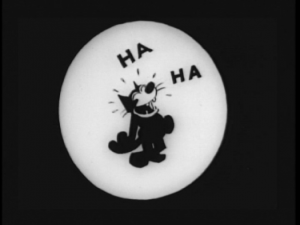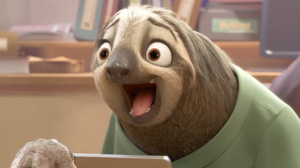
Felix the Cat silently chortled his “Ha Ha!” Mickey Mouse laughs (figure 1). Bugs Bunny snickers. Snoopy guffaws. In A Bug’s Life (1998, by John Lasseter), numerous insects laugh at their own jokes: “there’s a waiter in my soup.” When the Queen Ant philosophizes about the circle of life things, she sighs with “but that’s our lot in life—not a lot, haha.” The Black Widow titters when she remembers how her 12th husband died. A stick bug complains that people “always laugh at me,” and it takes the flea circus manager to remind him, shouting, “that’s because you’re a clown!” The best self-effacing humor of the bugs occurs in the outtakes, where the Grasshopper looks at the Princess and growls, “are you saying I’m stupid,” and she laughs, even on the 15th take.
Animated films offer one of the most fruitful fields for studying anthropomorphic representations, particularly in bridging that seemingly most human of activities: laughter. Animated films offer us various models of laughter and laughing, raising questions of what do fictional depictions of laughing animals, as extensions of human identities, suggest about human nature itself?
Aristotle was, allegedly, the first to characterize the human as a laughing animal. In his Nicomachean Ethics, he wrote that humans alone are “the only living things that laugh” (Aristotle, 1954). In the Poetics, he conceived of laughter as an act of superiority over others, where people are represented as “worse than us, not in the full sense of bad, but what we laugh at, is a subdivision of the ugly/shameful. The laughable is some kind of fault and ugliness/shame that involves no pain or harm—such as, obviously, a comic mask, which is ugly and distorted but free of pain” (Aristotele 1954: 33). In the Rhetoric, he points out that, when the comic mask becomes ugly, and one laughs at it, it can almost make the laugher into an animal. While an ambiguity exists regarding laughter as it relates to animal life, Aristotle does seem to suggest that the human is not only a rational animal, a political animal, or a language-using animal, but is also a homo ridens, a creature that laughs. In his writings on biology, he argues that a “child becomes human through laughter” (Aristotle 1954).
One of the earliest 20th century apologists of human laughter was the rollicking journalist/author G. K. Chesterton, who did not like “seriousness”. He posed the issue whether animals can laugh. He quipped:
The hyena is said to laugh; but it is rather in the sense in which the Minister of Parliament is said to utter ‘an ironical cheer.’ At the best, the hyena utters an ironical laugh. Broadly, it is true that all animals except Man are serious. Horses are serious; they have long, solemn faces. But horsey men are also serious—jockeys or trainers or grooms: they also have long, solemn faces. Dogs are serious: they have exactly that combination of moderate conscientiousness with monstrous conceit which is the makeup of most modern religions. But, however serious dogs may be, they can hardly be more serious than dog-fanciers (Chesterton 1921).[i]
But to Chesterton, the human was strange, almost in the sense of being a stranger on the earth. “Alone among the animals, he is shaken with the beautiful madness called laughter; as if he had caught sight of some secret in the very shape of the universe hidden from the universe itself” (Chesterton 1986: 168).
My preliminary question is: what do cartoon animals teach children and us about laughter? In what ways do they serve as exemplary or revelatory models for children’s laughter? According to children literary expert Michael Cart, the oldest and most universal type of humorous books for children is that of “talking animal humor” (Cart 1995: 15). And it is often those animals that show us what is funny.

When in Zootopia (2016, by Jared Bush and Byron Howard) Nick Wilde the Fox (Jason Bateman) tells Flash the Sloth (Raymond S. Persi), who works in the DMV, Department of Mammal Vehicles, a joke (“What do you call a three-humped camel?” “Pregnant”), it takes over seven seconds to register, but when it does, Flash laughs long and heartily, beginning with a full Duchene Zygomatic smile and ending up exercising his frontal/platysma muscles and a runaway titter (figure 2). The audience laughs watching a sloth slowly evolving into hysteria, a moment that invites the question of what the laughter of cartoon animals teaches us about laughter.
What will follow this question is the application of two typologies of laughter: those of British author C. S. Lewis (see 1968: 49-52) and Canadian psychologist Rod Martin (see 2003: 48-75). But the joke is I have already run out of my allotted words.
Terry Lindvall received his PhD from the University of Southern California. He currently occupies the C. S. Lewis Chair of Communication at Virginia Wesleyan University, and has published over ten books (most recently, God on the Big Screen: A History of Prayer in Hollywood Films from the Silent Era to Today from NYU Press).
References
Aristotle (1954). The Rhetoric and The Poetics of Aristotle (trans. W. Rhys Roberts), New York: Random House.
Cart, M. (1995). What’s So Funny?: Wit and Humor in American Children’s Literature, New York: HarperCollins.
Chesterton, G. K. (1921). “On Seriousness”, in G. K. Chesterton (ed.), The Uses of Diversity, New York: Dodd, Mead, and Company.
Chesterton, G. K. (1986). “The Everlasting Man”, in The Collected Works of G.K. Chesterton, vol. II, San Francisco: Ignatius Press.
Lewis, C. S. (1968). “Letter XI”, in The Screwtape Letters, London: Macmillan.
Martin, Rod, et al (2003). “Individual Differences in Uses of Humor and Their Relation to Psychological Well-being: Development of the Humor Styles Questionnaire”, Journal of Research in Personality 37(1): pp. 48–75.
[i] Chesterton points out: “Cats are as serious as the Sphinx, who must have been some kind of cat, to judge by the attitude. But the rich old ladies who love cats are quite equally serious, about cats and about themselves… Cats do not laugh—except the Cheshire Cat (which is not found in Egypt); and even he can only grin. And crocodiles do not laugh. They weep” (Chesterton 1921: 1-2).
